American and Canadian one-penny (one cent) coins (pink-red in color) look like they are made from the same metal — the element copper — but actually they are not. The difference in their composition allows a demonstration that is suitable for all ages. It raises questions: How come? How can this happen? The demonstration gives an answer why some one-penny coins, although the same color, shape, diameter and thickness, differ in mass. The demonstration is designed as a discrepant event1,2 — an approach where something surprises, puzzles and with guid-ance motivates students to study and learn the scientific concept.
The following demonstration can be done in a variety of ways. Basically, there are two sets of two pennies — one set having two pennies with a higher density than the other set. The pennies look the same to the students, so with the use of an equal-arm balance, the demonstrator can create a discrepant event.
Background
Alloying of metals — usually several metals are melted and mixed together — is a widespread method to improve their properties. Historically, American3 and Canadian4 pennies are used five metals: copper, zinc, tin, nickel and iron. The most common alloys are bronze and brass, where the element copper is 95% or more. However, in some years pennies in both countries were made by plating copper over either a core of pure zinc or other metals alloyed with zinc.
Applications
Elements, metals, alloys, mixtures, mass, density, plating, discrepant event
Materials
For the two sets of pennies, you can just experiment to obtain two pennies of similar mass for each set. Pennies will be suitable for this demonstration as long as pennies from different sets differ in mass by at least 0.1 g. Below are possible sets based on the date the pennies were minted. The composition of pennies based on minting dates can easily be found online.
The sets of pennies listed below has set #1 as the heavier set and set #2 as the lighter. Don’t mix American and Canadian pennies.
For USA pennies:
- Pennies #1: Set of two USA pennies, made 1982 and before
- Pennies #2: Set of two USA pennies, made 1983 and after
For Canadian pennies:
- Pennies #1: Set of two Canadian pennies made before 1983
- Pennies #2: Set of two Canadian pennies made after 1983
Use the round pennies if between 1982 and 1996, not the 12-sided. Basic equal-arm balance can be used for this demonstration. See page 12, this issue, for instructions if you would like to make one.
Preparations
Only the demonstrator will know which set of pennies has the greater density. The class will not know there is a difference between the pennies, at least not until the demonstration is finished. One strategy for the demonstrator to distinguish between the sets of pennies — without looking at the tiny minted dates — during the demonstration would be to select pennies for set #1 to be darker and set #2 to be more pinkish. Another possible way would be to always place the pennies with the greater density with “heads-up” on the balance pans. The lighter pennies will be “tails-up”.
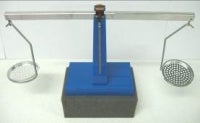 Demonstration
Demonstration
As you do each step of the demonstration, have students make predictions on whether the balance arm will remain horizontal, tilt to the right or tilt to the left.
Part A
- The demonstration starts with showing the balance with a balanced horizontal arm, Fig. 1.
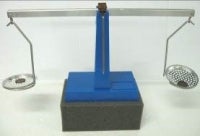 One penny #1 is added to each pan — the arm stays horizontal, Fig. 2.
One penny #1 is added to each pan — the arm stays horizontal, Fig. 2.- A second set of pennies, #2 is added to each pan with the same result — a level horizontal arm.
Part B
- One #1 penny is taken out from each pan and the balance arm, as expected, stays horizontal, as in Fig. 3.
- The pennies are placed back in the pans without any change to the arm
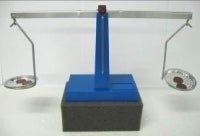 position.
position. - Now, one penny is removed from each pan: #1 penny from the left pan (leaving the lighter #2 penny) and #2 from the right pan (leaving the heavier #1 penny). The arm tilts to the right, Fig. 4.Students will be surprised because from the previous step, when one penny was removed from each pan, the balance arm stayed the same.
- The pennies are returned and the arm is balanced again, as in Fig. 3.
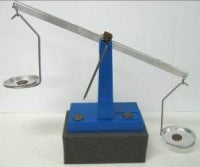
- In a similar manner, the balanced arm can tilt to the left, if #1 penny is removed from the right pan, and #2 penny is removed from the left pan, Fig. 5. Students will predict the arm to be balanced or tilted to the right.
- Returning the pennies to different sides — two #1 on the left pan and two #2 on the right pan — will not re-establish the balance. The balance will tilt to the left.
Explanation
Two of the four pennies in the 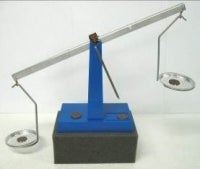 demonstration have less mass because of the difference in density of the metals, used to make the pennies.In Part A, the added two pennies in step 1 have the same mass therefore, the balance arm is horizontal.
demonstration have less mass because of the difference in density of the metals, used to make the pennies.In Part A, the added two pennies in step 1 have the same mass therefore, the balance arm is horizontal.
In Part B, the same or different numbered pennies are taken from each side, so the balance arm is horizontal or tilted. The balance arm will stay tilted if the returned pennies on each side are from the same set — two #1 pennies on one pan and two #2 pennies on the other.
References
- http://bcramond.myweb.uga.edu/home/DiscrepantEvents.html, accessed 08/25/2011.
- http://www.plu.edu/~vedrosr/discrepant.html, accessed 08/25/2011.
- http://en.wikipedia.org/wiki/Cent_(United_States_coin), accessed 01/21/2009.
- http://en.wikipedia.org/wiki/Penny_(Canadian_coin), accessed 01/21/2009.







